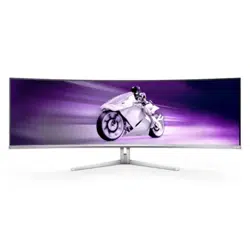Loading ...
Loading ...
Loading ...

43
• Press the
button to show the OSD
(On Screen Display) menu
• Press the
button to select the
option [Color] then press the
button to enter the color setting,
there are three settings as below.
1. Color Temperature: The settings
are as follows. Native, 5000K,
6500K, 7500K, 8200K, 9300K,
and 11500K. With settings in
the 5000K range the panel
appears "warm, with a red-white
color tone", while a 11500K
temperature yields "cool, blue-
white toning".
2. sRGB: This is a standard setting for
ensuring the correct exchange of
colors between dierent devices
(e.g. digital cameras, monitors,
printers, scanners, etc).
3. User Dene: The user can choose
his/her preferred color setting
by adjusting red, green, and blue
colors.
Note
A measurement of the color of light
radiated by an object while it is being
heated. This measurement is expressed
in terms of absolute scale, (degrees
Kelvin). Lower Kevin temperatures such
as 2004K are red; higher temperatures
such as 9300K are blue. The neutral
temperature is white, at 6504K.
Q9: Can I connect my QD OLED
monitor to any PC, workstation,
or Mac?
Ans.: Yes. All Philips QD OLED
monitors are fully compatible
with standard PCs, Macs, and
workstations. You may need a
cable adapter to connect the
monitor to your Mac system.
Please contact your Philips
sales representative for more
information.
Q10: Are Philips QD OLED monitors
Plug-and- Play?
Ans.: Yes, the monitors are Plug-and-
Play compatible with Windows
11/10/8.1/8, Mac OSX.
Q11: What is Image Sticking, Image
Burn-in, After Image, or Ghost
Image in QD OLED panels?
Ans.: Uninterrupted display of still or
static images over an extended
period may cause "burn-in", also
known as "after-imaging" or
"ghost imaging", on your screen.
"Burn-in", "after-imaging", or
"ghost imaging" is a well-known
phenomenon in QD OLED panel
technology. Please always turn
on the Screen Saver and Pixel
Orbiting functions from the On
Screen Display (OSD) menu. For
additional information, please
refer to Chapter 8 on Screen
Maintenance.
Warning
Failure to activate a screen saver, or a
periodic screen refresh application may
result in severe “burn-in” “after-image”
or “ghost image” symptoms that will not
disappear and cannot be repaired. The
damage mentioned above is not covered
under your warranty.
Q12: Why is my Display not showing
sharp text, and is displaying
jagged characters?
Ans.: Your QD OLED monitor works
best at its native resolution of
5120 x 1440. For the best display,
please use this resolution.
Loading ...
Loading ...
